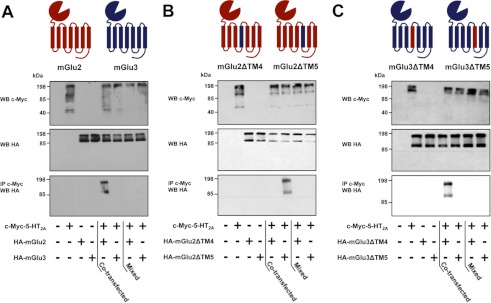FIGURE 2.
TM4 of mGlu2 mediates complex formation with the 5-HT2A receptor. A, co-immunoprecipitation (IP) experiments of c-Myc-5-HT2A and HA-mGlu2 or HA-mGlu3 in co-transfected HEK293 cells. The mGlu2, but not the mGlu3, co-immunoprecipitates with the 5-HT2A receptor. B, co-immunoprecipitation experiments of c-Myc-5-HT2A and HA-mGlu2ΔTM4 or HA-mGlu2ΔTM5 in co-transfected HEK293 cells. The presence of TM4, but not TM5, of the mGlu2 receptor is necessary to co-immunoprecipitate with the 5-HT2A receptor. C, co-immunoprecipitation experiments of c-Myc-5-HT2A and HA-mGlu3ΔTM4 or HA-mGlu3ΔTM5 in co-transfected HEK293 cells. The presence of TM4, but not TM5, of the mGlu2 conferred the capacity to co-immunoprecipitate with the 5-HT2A receptor. Schematic of mGlu2/mGlu3 chimeras studied are shown. For a control, cells separately expressing the c-Myc- or HA-tagged forms were mixed. Similar findings were obtained in two other independent experiments. WB, Western blot.

